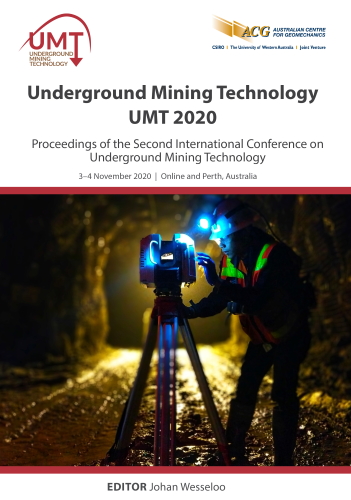Can new technologies shake the empirical foundations of rock engineering?

|
Authors: Elmo, D; Stead, D; Yang, B; Tsai, R; Fogel, Y |
DOI https://doi.org/10.36487/ACG_repo/2035_01
Cite As:
Elmo, D, Stead, D, Yang, B, Tsai, R & Fogel, Y 2020, 'Can new technologies shake the empirical foundations of rock engineering?', in J Wesseloo (ed.), UMT 2020: Proceedings of the Second International Conference on Underground Mining Technology, Australian Centre for Geomechanics, Perth, pp. 107-116, https://doi.org/10.36487/ACG_repo/2035_01
Abstract:
The past decade has witnessed an increasing interest in applications of machine learning (ML) to solve mining and geotechnical problems. This is largely due to an increased use of high-level programming languages, development of user-friendly and open source ML libraries, improved computational power, and increased cloud storage capacity to handle large and complex data sets. The benefit of incorporating ML in rock engineering design are apparent, including the reduction in the time required to sort and characterise field data and the capability to find mathematical correlations between overly complex sets of input data. However, when applied to geotechnical engineering, the question arises as to whether ML can truly provide objective results. In geotechnical engineering, where the medium considered is typically heterogenous and only limited information is spatially available, experience and engineering judgement dominate the early stage of the design process. However, experience and engineering judgement alone cannot reduce data uncertainty. It is also true that the inherent variability of natural materials cannot be truly captured unless sufficient field data is collected in an objective manner. This paper investigates the readiness of the technical community to integrate ML in rock engineering design at this time. To fully realise the potential and benefits of ML tools, the technical community must be willing to accept a paradigm shift in the data collection process and, if required, abandon empirical systems that are considered ‘industry standards’ by virtue of being commonly accepted despite acknowledging their limitations.
Keywords: cognitive biases, rock mass classification systems, uncertainty and variability
References:
Alghalandis, YF, Dowd, PA & Xu, C 2015, ‘Connectivity field: a measure for characterising fracture networks’, Mathematical Geosciences, vol. 47, issue 1, pp. 63–83.
Barton, N, Lien, R & Lunde, J 1974, ‘Engineering classification of rock masses for the design of tunnel support’, Rock Mechanics, vol. 6, pp. 189–236.
Bieniawski, ZT 1989, Engineering Rock mass classification, Wiley, New York.
Deere, DU & Deere, DW 1989, Rock Quality Designation (RQD) After Twenty Years, Rocky Mountain Consultants, Inc, Longmont, report prepared for Department of the Army, US Army Corps of Engineers, Washington.
Deere, DU, Merritt, AH & Coon, RF 1969, Engineering classification of in-situ rock, Air Force Weapons Laboratory, Air Force Systems Command, Kirtland Air Force Base, New Mexico.
Elmo, D 2006, Evaluation of a Hybrid FEM/DEM Approach for Determination of Rock Mass Strength Using a Combination of Discontinuity Mapping and Fracture Mechanics Modelling, with Emphasis on Modelling of Jointed Pillars, PhD thesis, University of Exeter, Exeter.
Elmo, D & Stead, D 2020a, ‘Disrupting rock engineering concepts: Is there such a thing as a rock mass digital twin and are machines capable of “learning” rock mechanics’, in PM Dight (ed.), Proceedings of the 2020 International Symposium on Slope Stability in Open Pit Mining and Civil Engineering, Australian Centre for Geomechanics, Perth, pp. 565–576,
Elmo, D & Stead, D 2020b, ‘The role of behavioural factors and cognitive biases in rock engineering’, Rock Mechanics and Rock Engineering, submitted for publication.
Elmo, D, Donati D & Stead D, 2018, ‘Challenges in the characterization of rock bridges’, Engineering Geology, vol. 245, pp. 81–96.
Elmo, D, Stead, D & Yang, B 2020, ‘Disrupting the concept of rock bridges’, Proceedings of the 52nd International Symposium on Rock Mechanics, American Rock Mechanics Association, Golden,
Heuze, FE 1971, ‘Sources of errors in rock mechanics field measurements and related solutions’, International Journal of Rock Mechanics and Mining Sciences, pp. 297–310.
Hoek, E 1999, ‘Putting numbers to geology, an engineer’s viewpoint, Quarterly Journal of Engineering Geology, vol. 32, pp. 1–19.
Hoek, E, Kaiser, PK & Bawden, WF 1995, Support of Underground Excavations in Hard Rock, A.A. Balkema, Rotterdam.
McGaughey, J 2020, ‘Artificial intelligence and big data analytics in mining geomechanics’, Journal of the Southern African Institute of Mining and Metallurgy, vol. 15, pp. 15–21.
Morgenroth, J, Khan, UT & Perra, M 2019, ‘An overview of opportunities for machine learning methods in underground rock engineering design’, Geosciences, vol. 9, issue 12.
Pells, PJ, Bieniawski, ZT, Hencher, SR & Pell, SE 2017, ‘Rock quality designation (RQD): time to rest in peace’, Canadian Geotechnical Journal, vol. 54, pp. 825–834.
Pu, Y, Apel, D, Liu, V & Mitri, H 2019, ‘Machine learning methods for rockburst prediction-state-of-the-art review’, International Journal of Mining Science and Technology, vol. 29, issue 4, pp. 565–570,
Taleb, N 2010, The Black Swan: The Impact of the Highly Improbable, Random House, New York.
Tye, W 1944, ‘Factor of safety – Or of Habit’, Journal of Royal Aeronautical Society, vol. 48, pp. 487–494.
Xu, C, Dowd, PA & Fowell, RJ 2006, ‘A connectivity index for discrete fracture networks’, Mathematical Geology, vol. 38, issue 5, pp. 611–634.
Yang, B, Elmo, D & Stead, D, 2020, ‘Questioning the use of RQD in rock engineering and its implications for future rock slope design’, Proceedings of the 52nd International Symposium on Rock Mechanics, American Rock Mechanics Association, Golden,
Zhang, Q & Song, J 1991, ‘The application of machine learning to rock mechanics’, Proceedings of the 7th ISRM Congress, International Society for Rock Mechanics and Rock Engineering, Lisbon.
Zhou, J, Li, X & Mitri, H 2016, ‘Classification of rockburst in underground projects: comparison of ten supervised learning methods’, Journal of Computer in Civil Engineering, vol. 30, issue 5.
© Copyright 2024, Australian Centre for Geomechanics (ACG), The University of Western Australia. All rights reserved.
View copyright/legal information
Please direct any queries or error reports to repository-acg@uwa.edu.au
View copyright/legal information
Please direct any queries or error reports to repository-acg@uwa.edu.au
